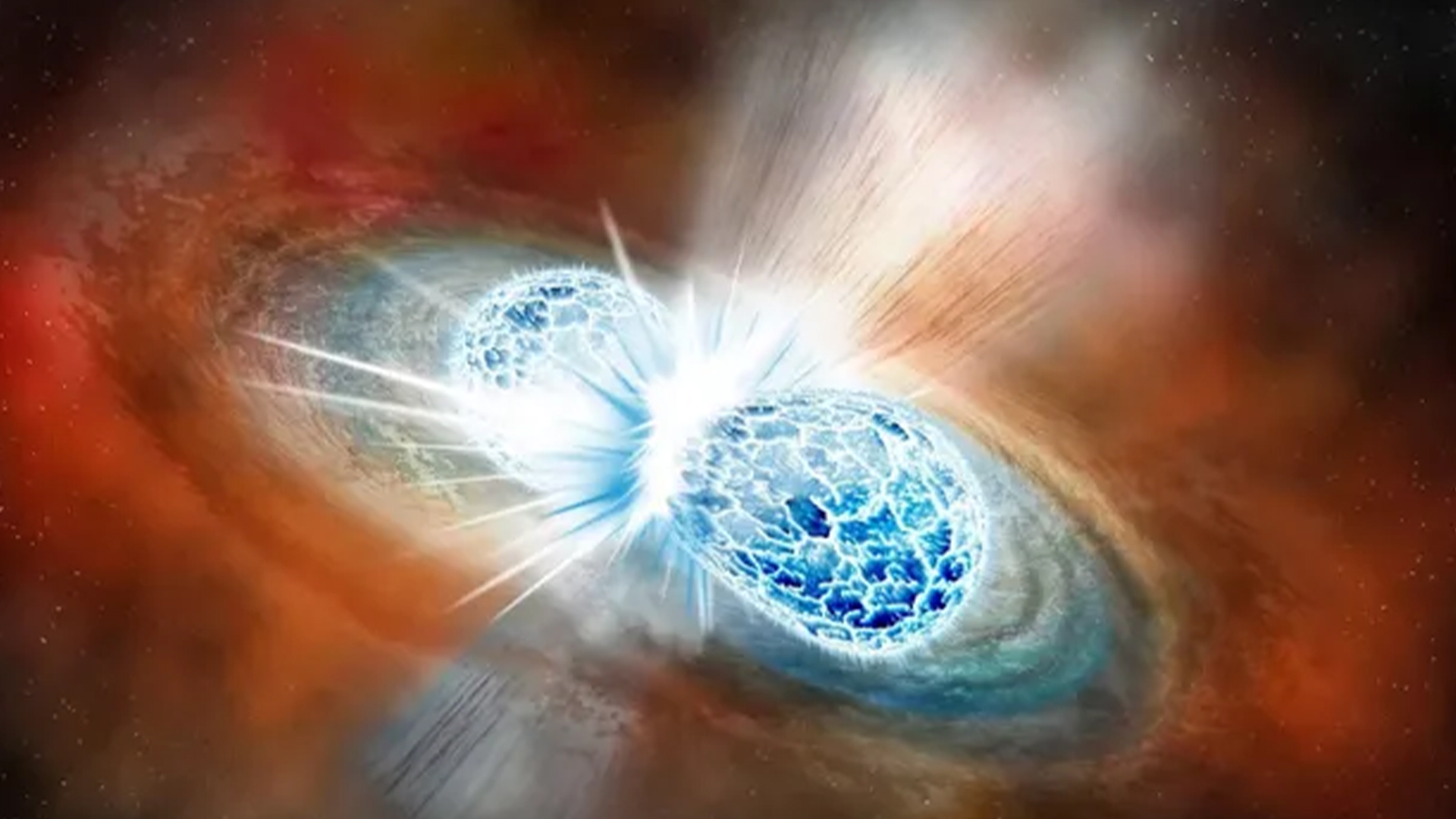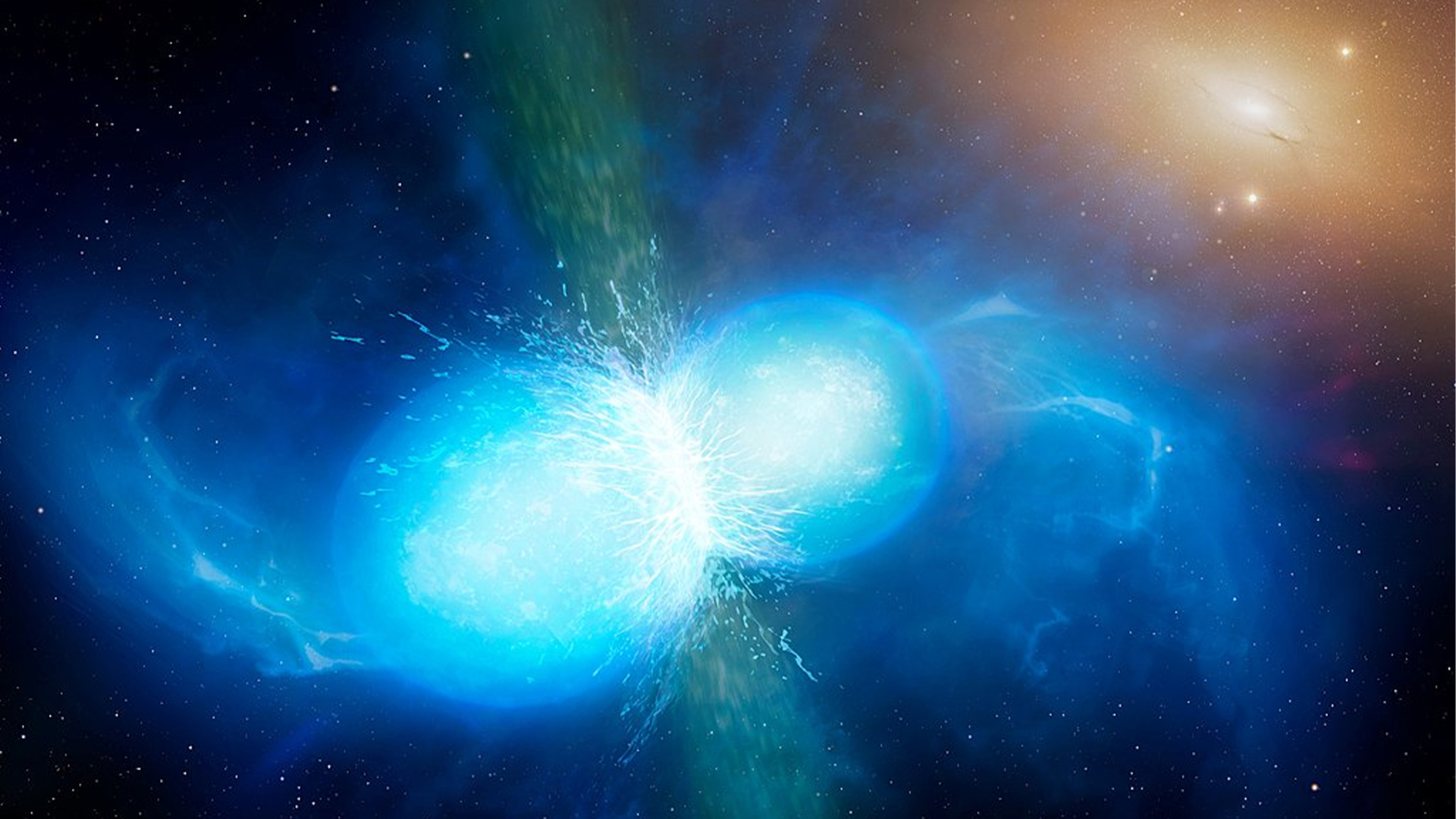
Scientists have determined the possible effects of a neutron star collision happening near Earth, finding that these so-called kilonovas could be real killers that would doom humanity. But don't worry, the collision would have to be really close to wreak havoc on our world. Nonetheless, here's what would probably go down.
"We found that if a neutron star merger were to occur within around 36 light-years of Earth, the resulting radiation could cause an extinction-level event," Haille Perkins, team leader and a scientist at the University of Illinois Urbana-Champaign, told Space.com.
Neutron star clashes that create bursts of light, called kilonovas, are considered the most violent and powerful events in the known universe. This is perhaps unsurprising, given that neutron stars are the collapsed remnants of dead stars and are made of matter so dense a teaspoon of one brought to Earth would weigh about 10 million tons. That's equivalent to 350 Statues of Liberty balanced on a spoon.
Not only do these dead star mergers create blasts of gamma rays and showers of charged particles moving at near-light speeds , known as cosmic rays, but they also generate the only environments we know of turbulent enough to forge elements heavier than lead, like gold and platinum. These elements can't even be created at the incredible ultra-high temperatures and pressures found in the hearts of massive stars.
Further, neutron star mergers set the very fabric of space "ringing" with ripples called gravitational waves, which can be detected here on Earth — even after traveling across billions of light years.
"Neutron stars can exist in binary systems, and when they merge, they produce a rare but spectacular event," Perkins said.
The team's research was based on observations of the neutron star merger behind gravitational wave signal GW 170817, picked up by Laser Interferometer Gravitational-Wave Observatory (LIGO) in 2017, and gamma-ray burst GRB 170817A.
Occurring about 130 million light-years away, this is the only neutron star merger thus far seen in electromagnetic radiation and heard in gravitational waves, making it a natural choice for investigating these powerful events.
A killer-nova?

Neutron star merger gamma rays are arguably the most obviously threatening aspect of these events. That's because this type of radiation carries enough energy to strip electrons from atoms, a process called ionization. And these ionizing blasts of radiation could easily destroy the Earth's ozone layer, resulting in our planet receiving lethal doses of ultraviolet radiation from the sun.
Perkins and her colleagues determined gamma rays coming from neutron star mergers — in twin narrow jets from either side of the merger — would pretty much roast any living thing that falls directly in their path for a distance of about 297 light-years. Fortunately, however, that effect has an extremely narrow range. In other words, it really would take a "direct hit" from a jet to give rise to such dramatic effects. But, there's another issue.
These jets are cocooned with gamma radiation in general, which would also affect the ozone layer of Earth if our planet was in their wider path — within about 13 light-years of them. This "off-axis" gamma-ray cocoon's ozone damage would also take 4 years to recover from. All in all, the gamma-ray cocoon strike would leave the Earth's surface exposed to harmful ultraviolet light for nearly half a decade.
Though gamma-ray effects of neutron star mergers are relatively short-lived, there is also another form of ionizing radiation these emissions give rise to, which is less energetic but longer-lasting.
When the jets of gamma rays hit gas and dust around stars, called the interstellar medium, this creates powerful X-ray emissions called the X-ray afterglow. Such X-ray emission lives longer than gamma-ray emissions and could also ionize the ozone layer, the team says. This, therefore, is arguably more lethal. Earth would need to be quite close to this afterglow before we have to be concerned about our fate, however — within a distance of 16.3 light years to be exact.
And we haven't gotten to the worst part yet.
The most threatening effect of the neutron star smash-up that the team discovered comes from those highly energetic charged particles, or cosmic rays, that spread away from the event's epicenter in the form of an expanding bubble. Were these cosmic rays to strike Earth, they would strip the ozone layer and leave the planet vulnerable to being blasted by ultraviolet rays for a period of thousands of years.
This would qualify as an extinction-level event, and Earth could be affected even if our planet were around 36 light-years away.
"The specific distance of safety and component that is most dangerous is uncertain as many of the effects depend on properties like viewing angle to the event, the energy of the blast, the mass of material ejected, and more," Perkins continued. "With the combination of parameters we select, it seems that the cosmic rays will be the most threatening."
Again, don't panic just yet!
Before lamenting that the end is nigh, it is worth weighing the apocalyptic picture painted by the impact of neutron star mergers against some other factors surrounding these events.
"Neutron star mergers are extremely rare but quite powerful, and this, combined with the relatively small range of lethality, means an extinction caused by a binary neutron star merger should not be a concern of the people on Earth," Perkins assured.
To get a picture of this rarity, throughout the 100 billion stars in the Milky Way, scientists have thus far only found one potential kilonova progenitor system, CPD-29 2176, which is located about 11,400 light-years from Earth.
"There are several other more common events like solar flares, asteroid impacts, and supernova explosions that have a better chance of being harmful," Perkins continued.
She added that some of these other events have been associated with mass extinction events on Earth already, with the most striking example of this being the impact of a massive asteroid that wiped out the non-avian dinosaurs and three-quarters of life on Earth around 66 million years ago in the Cretaceous-Tertiary extinction event.
Where this research does have important connotations is in the search for life elsewhere in the universe, as it certainly gives us an idea of the systems that aren't likely to enjoy the conditions needed to support life. (Life as we know it, at least.)
"Their conclusion that kilonovas could have a similar lethality to supernovas, but are much less common, coincides with what I believe would be likely to be the case," Niels Bohr Institute Cosmic Dawn Center scientist Darach Watson, who also studies kilonovas and was not involved in this research, told Space.com. "So overall, this is likely to be more of a threat for planets in old galaxies where the star-formation has ended, not so much in the Milky Way."
As for the team behind this research, Perkins explained that the next step is to observe more of these neutron star collision events.
"Currently, we only have one confirmed detection of a kilonova from a binary neutron star merger, so any more observations will constrain the unknowns," she concluded.
The team's research is published on the open-access paper repository arXiv.
Originally posted on Space.com.







